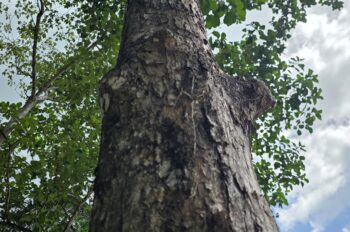Description
Description:
The Ziricote tree (Cordia dodecandra), a stunning tropical deciduous species, is a perfect blend of ornamental beauty, edible fruit, and valuable timber. Native to southern Mexico, Belize, Guatemala, Honduras, and Cuba, this tree thrives in tropical dry zones at elevations up to 900 meters (2,950 feet). It prefers well-drained, loamy soils with a neutral to alkaline pH and flourishes in full sun to partial shade. Considered a slow growing tree taking many years to reach maturity.
Reaching heights of 15–30 meters (50–98 feet) at maturity, with a typical spread of 10–15 meters (33–49 feet), the Ziricote forms a broad, rounded, or pyramidal crown, making it an excellent shade tree for tropical gardens. Its vibrant orange flowers bloom from February to May, creating a striking contrast against bare branches during the dry season, followed by pale yellow, apple-like fruits with a sweet, cinnamon-rose aroma.
Ideal for gardeners seeking a low-maintenance tree with ecological and cultural value, the Ziricote is a standout choice for tropical landscapes, offering both aesthetic charm and practical benefits.
Culture:
1. Climate
- Temperature: Ziricote prefers warm, tropical climates with annual temperature ranges between 19°C to 35°C (66°F to 95°F). It is not frost-tolerant.
- Rainfall: It grows naturally in regions with 900 to 2,000 mm (35 to 79 inches) of annual rainfall, typically in areas with a distinct dry season lasting 3 to 6 months. This makes it well-suited to seasonally dry tropical climates.
- Humidity: Ziricote thrives in warm, humid environments but can tolerate short periods of drought, making it relatively resilient.
2. Sunlight
- Light Requirements: Ziricote trees require full sun to partial sun exposure for optimal growth. They need ample sunlight, though young plants may benefit from some shade to prevent stress.
3. Soil
- Soil Type: Ziricote performs best in well-draining, loam soils with a high limestone content. It prefers neutral to slightly alkaline soils with a pH range of 7.0 to 8.5.
- Drainage: Good drainage is critical to prevent root rot, as overwatering or waterlogged soil can harm the tree.
- The tree can adapt to rocky or limestone-rich soils, which are common in its native tropical dry zones.
4. Watering
- Watering Schedule: Water Ziricote trees approximately once a week, allowing the soil to dry slightly between waterings to avoid overwatering, which is a common issue.
- Drought Tolerance: The tree is relatively drought-tolerant once established, making it low-maintenance in regions with seasonal dry periods.
- Establishing Seedlings: Young trees may require more frequent watering until their root systems are established.
5. Location and Habitat
- Native Range: Ziricote grows naturally in tropical deciduous forests, particularly in limestone-rich areas of southern Mexico, Belize, Guatemala, Honduras, and Cuba.
- Coastal Areas: It can grow near the ocean, showing tolerance to slightly saline conditions, which makes it suitable for coastal landscapes.
- Site Selection: Choose a site with good air circulation and protection from strong winds, as the tree’s broad crown can be susceptible to damage.
6. Growth Rate
- Growth Rate: Ziricote is a slow-growing tree, often taking many years to reach maturity, which can range from 15 to 30 meters (50 to 98 feet) in height, depending on conditions.
7. Care and Maintenance
- Pruning: Minimal pruning is needed, mainly to remove dead or damaged branches and maintain the tree’s shape. Pruning can also encourage a denser canopy.
- Pests and Diseases: Ziricote is relatively resistant to pests and diseases due to its dense, rot-resistant wood.
- Fertilization: Applying a balanced fertilizer during the growing season can support healthy growth, especially in nutrient-poor soils.
Faunal Associations:
Ziricote has several notable animal associations due to its ecological role in its native tropical dry forest habitats.
- Pollinators: The tree’s vibrant orange flowers, blooming from February to May, attract a variety of pollinators, particularly bees and butterflies. Species such as native stingless bees (Meliponini) and other tropical pollinators are drawn to the nectar, facilitating cross-pollination.
- Frugivores: Ziricote produces pale yellow, apple-like fruits with a sweet, aromatic flavor in July. These fruits are consumed by various birds and mammals, including parrots, toucans, and small mammals like opossums and rodents, which aid in seed dispersal.
- Insects: The tree supports insect populations, including wood-boring beetles and other species that interact with its prized timber. These insects may colonize dead or decaying wood, contributing to nutrient cycling.
- Wildlife Shelter: The broad, rounded crown provides habitat and nesting sites for birds and small arboreal mammals. Its dense foliage offers shade and refuge in hot, dry climates.
These associations make Ziricote a valuable species for supporting biodiversity in tropical ecosystems, enhancing its appeal for eco-conscious gardeners.





